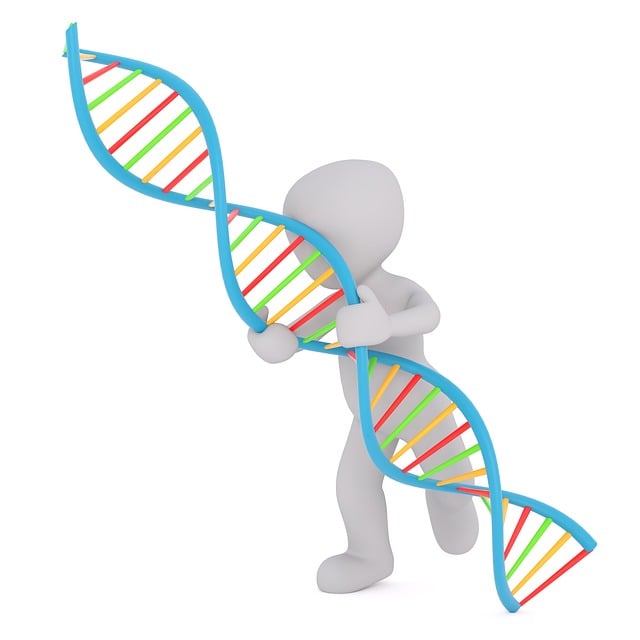NAD Therapy: Can It Slow Down Cellular Aging?

NAD therapy for aging aims to reverse natural NAD+ decline, supporting sirtuin function and cellular…….
In the ever-evolving realm of healthcare, the quest for innovative treatments that address complex genetic disorders has captivated researchers and clinicians worldwide. Among these groundbreaking advancements, Nad Therapy for DNA Repair stands out as a promising approach, offering new hope for managing and potentially reversing DNA damage. This comprehensive article aims to delve into the intricate world of Nad Therapy, exploring its mechanisms, global impact, economic implications, technological breakthroughs, regulatory landscape, and its potential to shape the future of genetic medicine. By the end, readers will grasp the significance of this therapy and its promise in addressing one of humanity’s most pressing health challenges—DNA repair.
Definition: Nad Therapy for DNA Repair refers to a therapeutic strategy that utilizes nicotinamide adenine dinucleotide (NAD+) as a cofactor to enhance cellular DNA repair mechanisms. NAD+ is a vital coenzyme involved in numerous biological processes, including energy metabolism and DNA maintenance. This therapy aims to mitigate DNA damage, a hallmark of aging and various diseases, by boosting the body’s inherent repair capabilities.
Core Components: The therapy involves several key elements:
NAD+ Supplementation: The primary focus is on increasing cellular NAD+ levels through exogenous supplementation. This can be achieved through dietary modifications or pharmaceutical interventions. Nicotinamide riboside (NR), a precursor to NAD+, has gained prominence as a potential dietary supplement for NAD+ replenishment.
DNA Repair Pathways Activation: NAD+ plays a crucial role in activating and regulating DNA repair enzymes. By enhancing NAD+ availability, this therapy stimulates the activation of various DNA repair mechanisms, including base excision repair (BER), nucleotide excision repair (NER), and homologous recombination (HR).
Cellular Health and Longevity: The ultimate goal is to promote cellular health and longevity by reducing oxidative stress and DNA damage. This approach aligns with the growing understanding of the role of cellular senescence and DNA damage accumulation in aging-related diseases.
Historical Context: The concept of NAD+ as a cellular rejuvenator dates back to the mid-20th century when researchers first identified its essential role in energy metabolism. However, it was not until recent years that scientists began exploring its potential in DNA repair and longevity. A landmark study in 2013 by Dr. David Sinclair and his team at Harvard Medical School demonstrated that increasing NAD+ levels could activate sirtuins, a class of proteins associated with longevity and DNA repair. This discovery ignited a surge of interest in developing NAD+ therapies for various diseases.
Nad Therapy for DNA Repair has garnered significant international attention, leading to diverse global trends:
Research Leadership: The United States, Europe, and Japan have been at the forefront of research, with numerous universities and pharmaceutical companies investing heavily in NAD+ therapy. These regions are witnessing rapid advancements in understanding the molecular mechanisms of NAD+-mediated DNA repair.
Clinical Trials: There has been a surge in clinical trials exploring NAD+ therapy for various conditions, including age-related neurodegenerative diseases, cancer, and cardiovascular disorders. The US National Institutes of Health (NIH) has funded numerous studies, highlighting the government’s interest in this area.
Market Potential: The global market for NAD+ supplements and related therapies is projected to grow exponentially. According to a 2022 report by Market Research Future (MRFR), the NAD+ therapy market is expected to reach USD 5.6 billion by 2027, reflecting a CAGR of 14.5% during the forecast period (2020-2027).
Regional Variations: Europe, particularly Germany and the UK, has a strong regulatory environment, fostering robust clinical trials. Asia-Pacific countries like Japan and South Korea are leading in NAD+ skincare products, leveraging its anti-aging properties.
The economic implications of Nad Therapy for DNA Repair are multifaceted:
| Aspect | Description |
|---|---|
| Market Dynamics | The market is characterized by a mix of established pharmaceutical companies and innovative startups. Large pharma firms are investing in research and development, while startups focus on niche applications and personalized medicine. |
| Investment Patterns | Funding for NAD+ research has increased significantly, attracting investments from venture capital firms and angel investors. The potential for developing novel therapies has sparked interest in both academic and industry settings. |
| Cost-Effectiveness | While initial costs for therapy development are high, the long-term economic impact could be substantial. Successful implementation could lead to reduced healthcare expenditures related to chronic diseases and improved quality of life, especially among elderly populations. |
| Healthcare Systems Integration | Integrating NAD+ therapy into existing healthcare systems will require careful consideration of reimbursement policies and clinical guidelines. Payers and policymakers must balance the potential benefits against current treatment costs. |
Technological breakthroughs have been instrumental in advancing Nad Therapy:
NAD+ Synthesis and Delivery: Researchers have made significant strides in developing efficient methods for NAD+ synthesis, including recombinant production of NR and other precursors. Improved delivery systems, such as liposomal formulations, ensure better cellular uptake and bioavailability.
Genetic Engineering: The use of gene therapy techniques to enhance NAD+ biosynthesis has shown promise. CRISPR-Cas9 technology allows precise editing of genes involved in NAD+ metabolism, offering potential for treating genetic disorders associated with NAD+ deficiency.
Nanotechnology: Nanoparticle-based drug delivery systems are being explored to target specific cells and tissues, enhancing the efficacy of NAD+ therapy while minimizing side effects.
In Silico Modeling: Advanced computational models are aiding in predicting drug interactions and optimizing treatment regimens, accelerating the drug discovery process.
The regulatory environment for Nad Therapy for DNA Repair is dynamic and evolving:
Regulatory Bodies: Key regulatory authorities include the US Food and Drug Administration (FDA), the European Medicines Agency (EMA), and Japan’s Pharmaceuticals and Medical Devices Agency (PMDA). These agencies are responsible for evaluating the safety and efficacy of new therapies.
Clinical Trial Requirements: Rigorous clinical trials are essential to demonstrate therapeutic efficacy and safety. Phase I, II, and III trials follow strict protocols to monitor adverse events and assess biomarker responses.
Emergency Use Authorization (EUA): During public health emergencies, regulatory bodies may grant EUA for promising therapies. This has been a significant pathway for COVID-19 treatments, and it could apply to NAD+ therapy for critical conditions in the future.
Post-Market Surveillance: Even after approval, ongoing surveillance is crucial to identify rare adverse events and ensure long-term safety. Manufacturers must maintain robust pharmacovigilance programs.
Nad Therapy for DNA Repair holds promise across various therapeutic areas:
Neurodegenerative Diseases: Age-related neurodegenerative conditions, such as Alzheimer’s and Parkinson’s diseases, are associated with DNA damage accumulation. NAD+ therapy could potentially mitigate neurodegeneration by reducing oxidative stress and improving DNA repair mechanisms.
Cancer: Cancer cells often exhibit impaired DNA repair pathways. Enhancing NAD+ levels might sensitize cancer cells to chemotherapy and radiation while protecting healthy cells, leading to more effective tumor treatment.
Cardiovascular Disorders: Oxidative stress contributes to cardiovascular disease pathogenesis. NAD+ therapy may offer cardioprotection by reducing inflammation and improving vascular function.
Metabolic Syndromes: Type 2 diabetes and metabolic syndrome are linked to disrupted cellular energy metabolism and DNA damage. Targeting NAD+ levels could provide a novel approach to managing these conditions.
Aging-Related Conditions: Beyond diseases, NAD+ therapy has anti-aging properties, as it may reverse age-related epigenetic changes and improve overall cellular health. This has sparked interest in the cosmetics and wellness industries.
Despite its promise, Nad Therapy for DNA Repair faces several challenges:
Dosage and Delivery: Optimizing effective doses and delivery methods remains a priority. Variability in individual NAD+ levels and metabolism requires personalized approaches.
Long-Term Safety: Longitudinal studies are necessary to assess the long-term safety and sustainability of NAD+ therapy, especially regarding potential dependence on supplementation.
Combination Therapies: Exploring synergistic effects with other treatments, such as traditional medications or stem cell therapies, could enhance therapeutic outcomes.
Access and Affordability: Ensuring equitable access to NAD+ therapies is crucial, particularly in low- and middle-income countries. Cost considerations will play a significant role in shaping healthcare policies.
Nad Therapy for DNA Repair represents a promising frontier in genetic medicine, offering potential solutions to age-related diseases and conditions associated with DNA damage. The global response to this therapy underscores its significance and the urgent need for novel treatments. As research progresses, we can expect continued advancements in technology, regulatory clarity, and therapeutic applications.
The future of NAD+ therapy holds immense potential, from extending healthy lifespans to improving quality of life for those suffering from debilitating diseases. However, a balanced approach is essential, considering both the opportunities and challenges. Continued investment in research, collaboration among stakeholders, and thoughtful regulation will shape the trajectory of Nad Therapy and its impact on human health.

NAD therapy for aging aims to reverse natural NAD+ decline, supporting sirtuin function and cellular…….

NAD therapy for DNA repair boosts cellular metabolism and activates specific DNA repair pathways to…….

NAD+ therapy, targeting NAD+ to activate sirtuins, offers a revolutionary approach to combat age-rel…….

NAD+ for cellular repair plays a crucial role in maintaining mitochondrial health by neutralizing fr…….

NAD therapy for aging is a promising anti-aging approach focusing on raising nicotinamide adenine di…….

NAD+ therapy targets mitochondrial DNA (mtDNA) repair by enhancing NAD+ levels, addressing age-relat…….

Nicotinamide adenine dinucleotide (NAD+) plays a dual role in mitochondrial DNA (mtDNA) repair, serv…….

DNA regeneration with NAD therapy emerges as a promising cancer prevention strategy. As age decrease…….

NAD therapy for DNA repair targets cellular health and longevity by boosting NAD+ levels to enhance…….